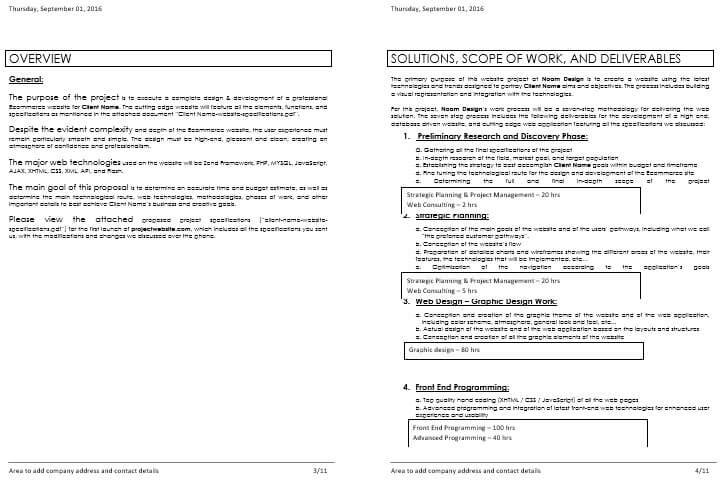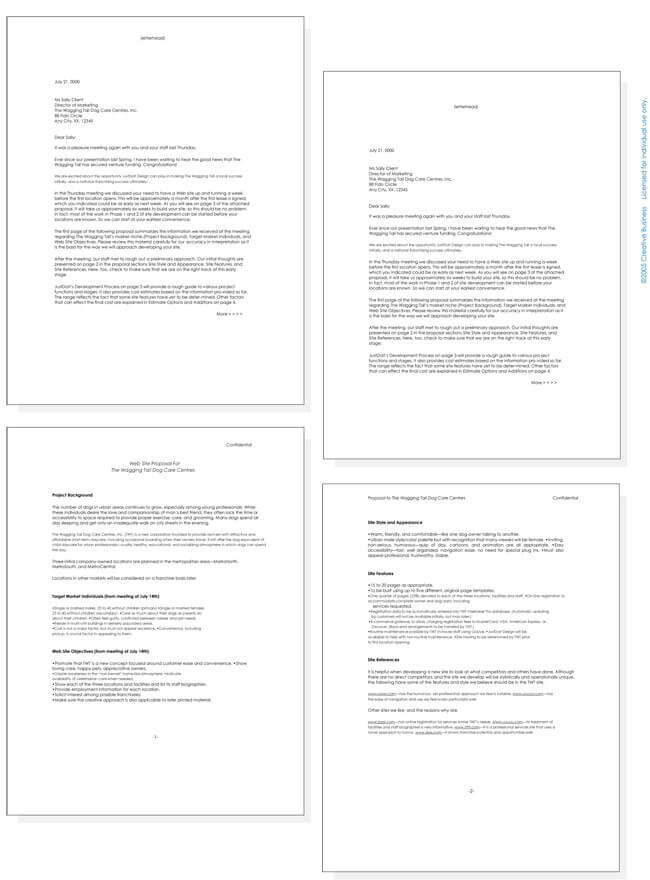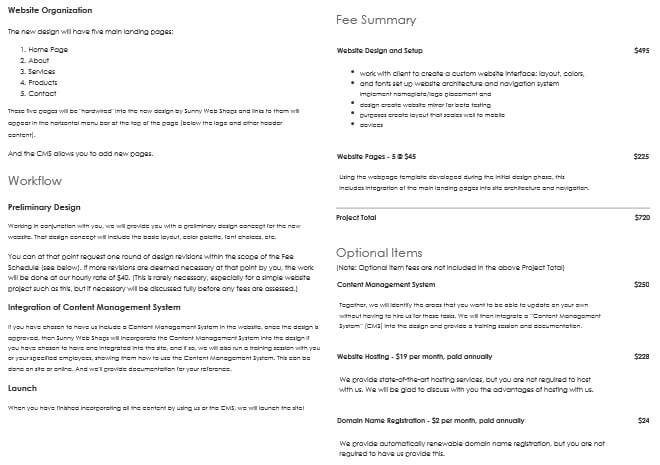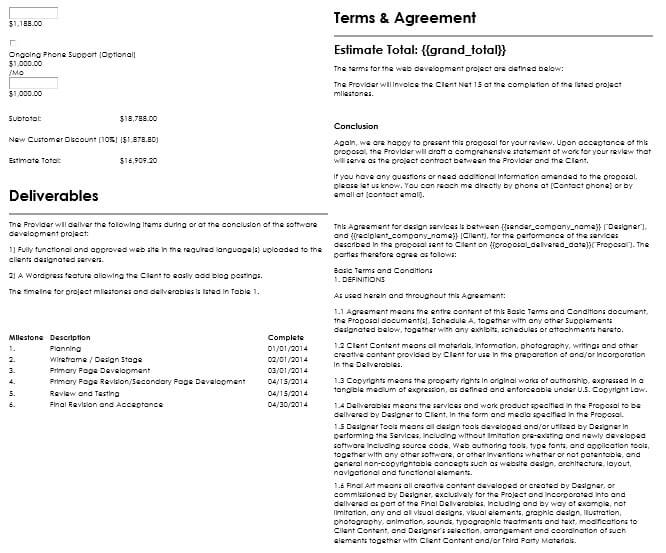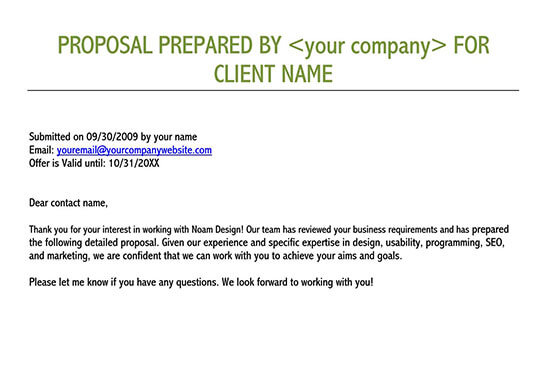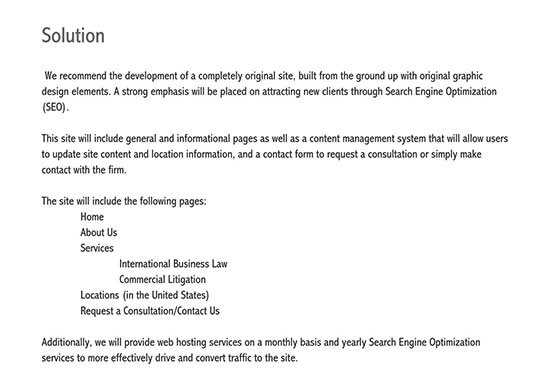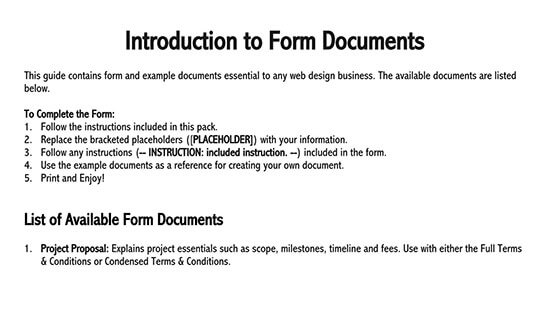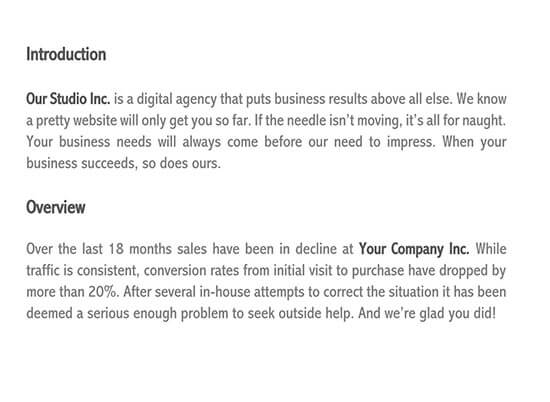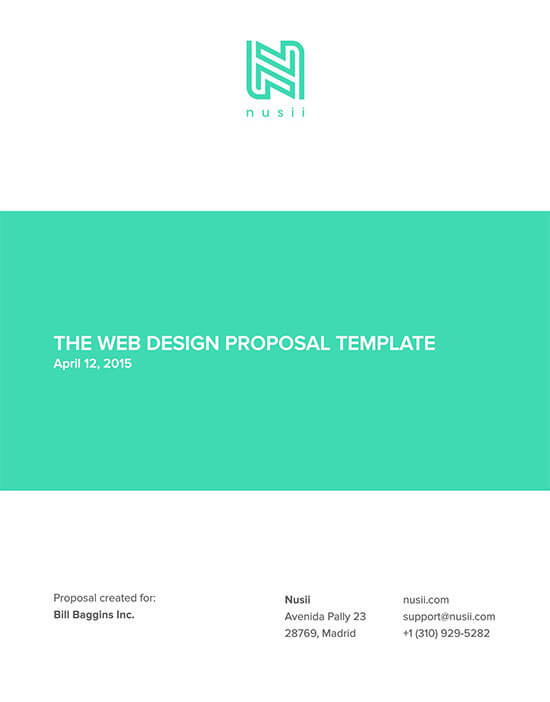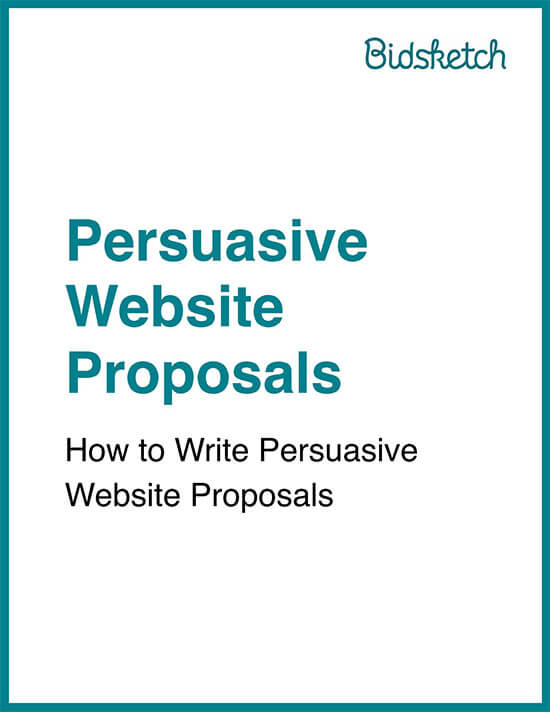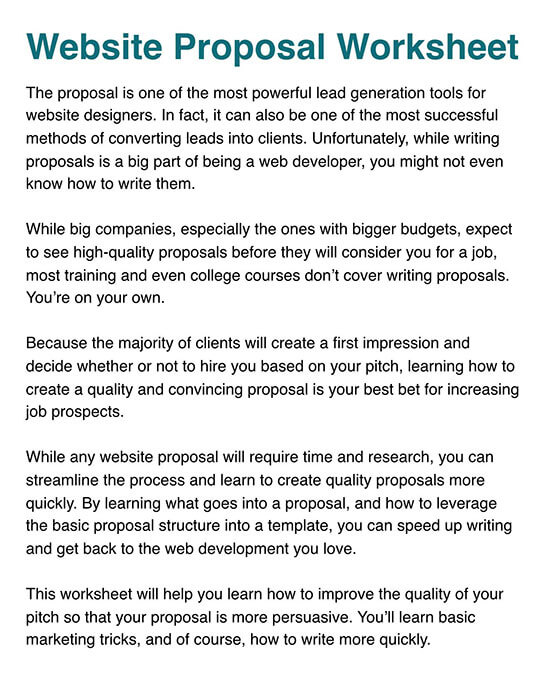A website development proposal can often be tedious, droning, and at times one may feel like it’s a waste of their valuable and productive time. A website development proposal is that one thing which you must do right; otherwise, you may end up losing the project to your competitors. The ultimate rule in writing a winning proposal is to follow a standard structure that ultimately works. Other than drafting a proposal whose aim is to clarify and establish the roles and objectives of the project, your document should contain all the needed information that will make your proposal stand out from your competitors.
One of the key skills required for creating a new website is an eye-catching design: your website development proposal needs to showcase your design services and be designed to capture the attention of anyone. Other than drafting the content on your proposal, you must set aside some time to design it such that it looks spectacular.
To help make your work much easier in drafting and designing the document, you can use the samples provided and our professionally designed templates and tailor them to create a proposal that will best suit your client’s needs.
Building Blocks of a Website Development Proposal
Whereas the actual website development proposal is valuable to the client, and one should dedicate their time with it, it will make a significant impact if one took their time in designing it to stand out. To do this, one should dedicate enough time to it, and not rush just to get done with it.
To ensure that you have captured all the information the client needs to hire you, one should establish a standard structure to use when writing their proposals. You can also do this by downloading our professionally designed web development proposals to make your work much easier. This way, you will not only ensure that you don’t leave out important details but also you won’t have to start from scratch every time you are writing to a new client.
In most cases, your proposal will be the only agreement you have with the client. It is, therefore, important that you nail down all the right details.
A standard website development proposal should include:
- Cover page: this letter should be addressed to your client. The cover letter must have the project name – this is especially important if you are responding to an RFP – and an introduction to your design elements. One can also use this letter to include a one-paragraph overview of the proposal.
- Confidentiality statement: all projects differ from one another. Including simple confidentiality, the statement informs the recipient of the information that the information included in the proposal should not be given out publicly without your consent.
- Problem statement: state and provide a brief explanation of the problems the client is trying to solve. This section is what will show the client that you understood what they are looking for.
- Recommendation solutions and services offer your solution to the problems you have listed. How will you help the client meet their needs?
- Approach and process: explain the method and approach you will use in tackling the problems and how long the project is expected to take. You can also introduce some of your team members who will be working on the project.
- References: provide examples of some of the clients you’ve worked with on similar projects. The examples you provide help in showcasing your portfolio as well as provide references.
- Fees and pricing: provide a detailed breakdown of the cost associated with the project. You can also include an agreement that shall be used to initiate the project.
- About/company information: include a brief explanation about your company, any accreditations you have, and any specialization you do.
How to Write a Website Development Proposal
Your web development proposal should be written in a persuasive tone. This document will help you land or lose a client. You should use a conversational tone to sell the benefits of what you propose to offer to the client.
Whereas the primary goal of a web development proposal is to land a client, the document more serves to secure you a meeting with a prospective client so you can talk about your web development skills in person.
Before writing, however, one must first understand what the client needs. This way, you will be able to get targeted information from the client that will help you in tailoring the proposal and your plans to their exact requirements. Without properly understanding the client’s needs, your proposal will be generic, savorless, and forgettable.
Here are some few questions you should have the answers to before getting started on the proposal:
- Why have they initiated the project?
- What is their target audience?
- What integrations will be necessary?
- Why do they need the website?
- What is their expectation of the new website?
- In what ways are they expecting the website to affect their business?
- To what extent will the website promote and showcase products and services?
- How will the website fit into their digital marketing strategy?
- Who are their main competitors?
- What is their inspiration?
- Are there established aesthetic guidelines the web development process should follow?
- What is the launch date for the project?
Things to Avoid when Writing a Web Development Proposal
Writing a proposal is not always fun. Most people usually speed through the writing process just to check off the basic items of their checklist. But if you are not too careful, you may make mistakes that would get your proposal thrown in the trash can. Even worse, you could establish a poorly-defined relationship that would quickly turn into a nightmare for both you and the client.
Things to watch out for include:
Lackluster design
Even if you are the type that draws a line between graphic design and web development, the fact is that function and form are two sides of the same coin. Most clients would come readily through your proposal in the recycle bin if it doesn’t look inviting and compelling to them.
It is thus of the essence that you make your proposal look good. Make the client feel like the proposal is already a part of their business- use a tone of voice and creative elements to mesh it with their brand and company culture.
Even better, you can showcase your chops by making the web development proposal itself an example of your prowess.
Undefined business goals
When drafting your web proposal, you must make sure to focus on the client’s requirements. Avoid adding unnecessary details. Tailor your proposal to fit the client’s business goals. Also, make sure that you have addressed the individual issues the client is dealing with, not just “developing a website.”
Ignoring integrations
With the new technological advancements, a new website can no longer just be a website. Clients desire dynamism and personalization for their brands. This basically means integration.
This could range from linking their social media accounts to accessing proprietary client-side content management systems. Regardless of the type or level of integration necessary, your web development is most certainly going to mesh with some other systems, and you need to find out from your client what those systems are.
Drafting a winning proposal can be a drain on time and resources, no doubt. But if you view your proposal as though you were the end-user and optimize the actual user experience of your sales prospecting, you can convert your efforts into a solid sales channel.
With a little bit of time, effort, and ingenuity, tittivating your web development proposal can help improve your chances of landing a new project. Revamp your web development proposals with the samples and our ready to use templates and start closing deals.
Free Samples & Examples
Website Development Proposal: Sample
Prepared On:
Valid Until:
Prepared By:
Prepared For:
Introduction
Thank you for showing your interest in teaming up with us for your website development project.
At [Your company name], we hold one goal above all our competitors and that is 100% client satisfaction. Our dedicated team of copywriters, web designers, web developers, and graphic designers uphold the highest standards for project planning, development, and execution, and we are determined to build a perfect website for your company on-time and on-budget.
We have built and designed websites for several companies around the world with great success, and we are quite excited to get started on yours.
In this web development proposal, you will find our previous work along with what we feel is the best solution for your web development needs, along with the associated cost, delivery timeline, and project terms and conditions.
Thanks again for this opportunity to work with you.
____ (Your Name)
___ (Title)
___ (phone number)
___ (Email address)
Executive Summary
____ [client’s company name] needs a full website built to support your digital growth strategy. A website that will enable you to expose your brand to live audiences via leveraged digital advertising and search engines to promote lead generation and deployment of content marketing strategies to help build brand awareness and authority.
____ [Your company name] is distinctively qualified to build the website that you require, due to our in-house team of developers, designers, writers and our experience in working with clients in __ [name of clients industry].
Our previous work includes:
i. Project name
Description
Images
ii. Project name
Description
Images
iii. Project name
Description
Images
iv. Project name
Description
Images
Solution Outline
______ [your company name] will build your website using the content management system (CMS) which is used by most major companies around the globe. The CMS system is known for its ease of use, scalability, and security. This system will enable you to do the following once completed:
• Integrate with analytics software to track site performance
• Easily update and edit content and images
• Post new content to your company blog easily
We recommend that your website be hosted with _ [host] using __ [hosting type]. This will ensure that your site is able to support a high volume of traffic while remaining protected from any malicious entities.
Site Structure
The website shall have the following pages:
• Home
• Blog
• About
• Contact
Site Integration
___ [your company name] will integrate your website with the following:
• Google Analytics
• Content management platform
• Marketing Automation
These integrations will help you in monetizing your website.
Execution Timeline
The following table provides a breakdown of our project execution timeline
Stage Completion Date
Project kick-off meeting
Design Wireframe
Page design and mocap
Site copy
Functional Prototype
Website Development complete
Testing and launching
Project Costs
The table below shows the cost associated with the project.
Name Price Qty Subtotal
Initial Invoice
Approved Design Invoice
Ongoing Fees
The table below details the monthly fees you will be required to pay once the website is successfully launched.
Name Price Qty Subtotal
Hosting
Standard Business Support Hours
Terms of Agreement
Some of the basic items to add on your terms of agreement page include
• Authorization
• Payment
• Completion
• Assignment of Project
• Revision During Execution
• Legal and Licence
• Copyrights and Trademarks
• Sole agreement
• Copyright to project
• Initial Payment and refund policy
___ [Your Name]
___ [Signature]
___ [Date]
Free Downloads
FAQs
What is a website proposal?
A website design proposal outlines your proposed site design, navigation structure, content library, and target audience. A website design proposal can also include a database of information incorporated into the site or used for reference purposes.
What should a website proposal include?
The website design proposal should include an overview of the site; content library, current company, and product information; a description of the site’s target audience and purpose; and a proposed method for linking to other websites. It should also include the site’s design, content structure, and navigation procedures.
How long should a website proposal be?
A website design proposal should be long enough to clearly explain the proposed site design, content structure, and navigation procedures but short enough to be readable and understandable. Generally, your website design proposal should be two to three pages long, with one additional page for the site’s sample design and navigation structure.
